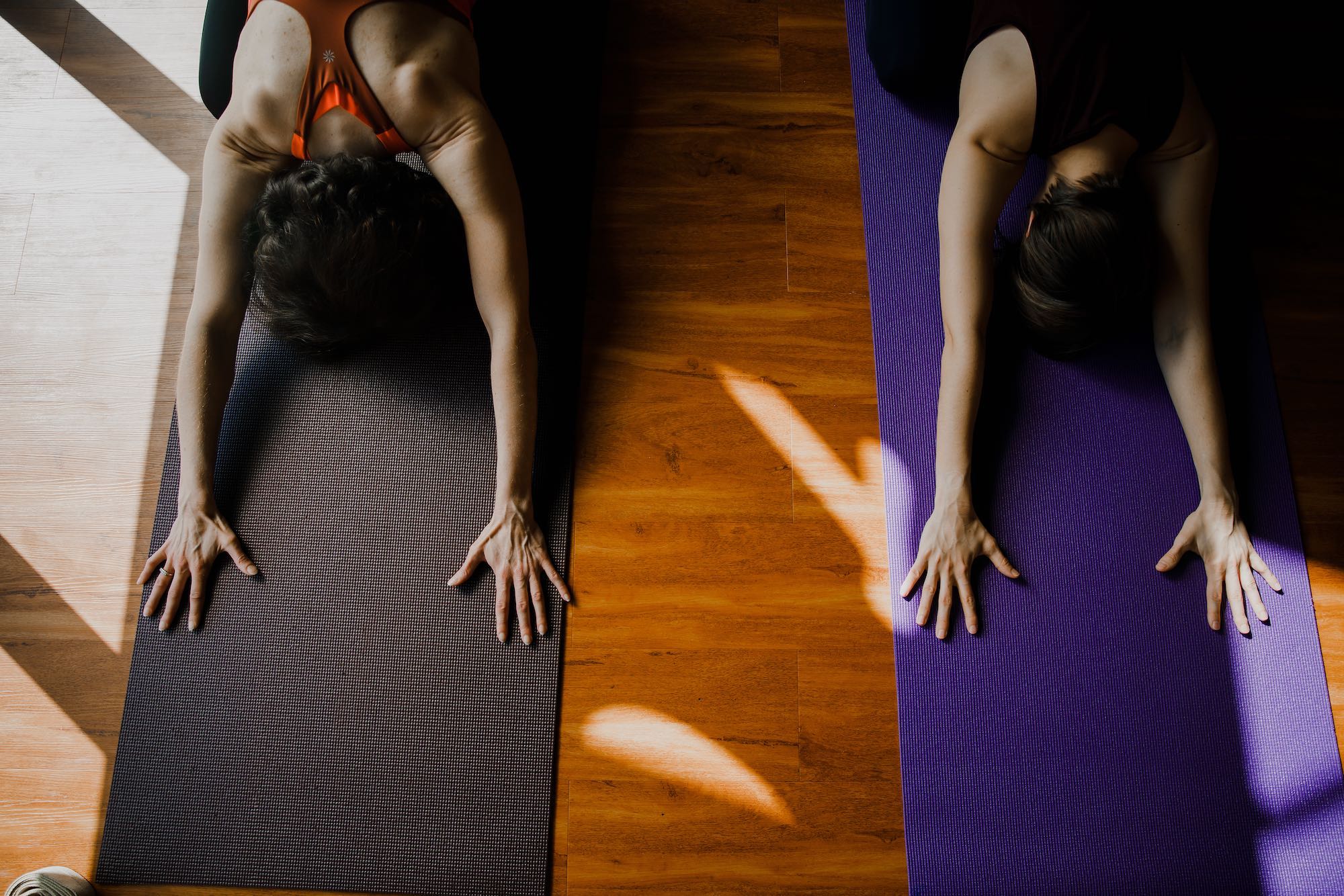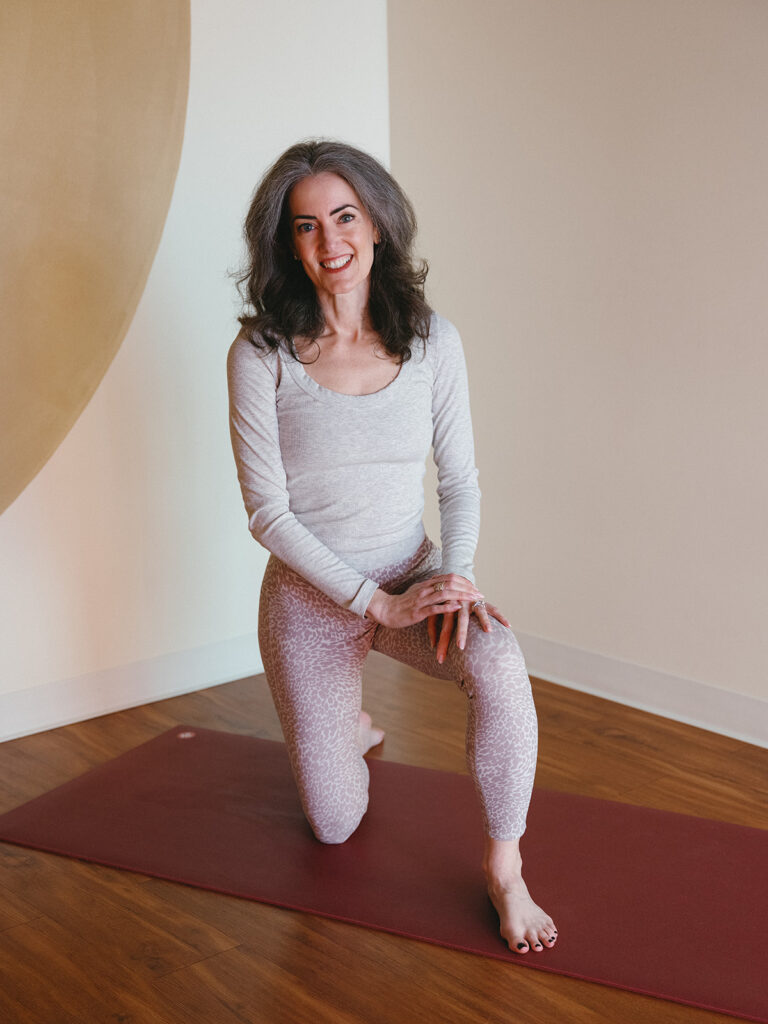Taking a yin yoga teacher training is smart not only for expanding your teaching repertoire, but also for honing your ability to teach balanced classes to students of all levels. Let’s look at what yin yoga is, how you can learn to teach yin yoga, and how adding a yin yoga teacher training to your résumé will make you a better teacher to all of your students.
Yin yoga has many differences from yang styles of yoga like hatha, vinyasa, and Kundalini. Yin yoga includes long—some might say very long—holds of poses low to the ground, with the idea of applying low-grade stress to the body to stimulate adaptation in the yin tissues of the body: bones, joint capsules, fascia. And yin gives extra agency to students to personalize their own practice. Depending on how the practitioner sets up any given shape and how they use props, yin yoga can feel like a deep, intense stretch, or it can feel like restorative yoga.
how does yin yoga work?
When I teach yin yoga, I follow the model I lay out in my book The Art of Yoga Sequencing. A well-rounded yin sequence will take the spine through the three planes of movement: forward and back in the sagittal plane (spinal flexion and extension), side to side in the frontal plane (lateral spinal flexion), and twisting in the transverse plane (spinal rotation). It will also apply intentional low-grade stress to the front, back, inner, and outer lines of the hips. You’ll find several sample yin yoga lesson plans in The Art of Yoga Sequencing.
In my approach and most approaches, there are three general principles we follow:
- Find the appropriate degree of stress for the shape
- Settle in: get still and quiet
- Stay a while—typically, 2–6 minutes per shape
But my approach is not the only one! For a general overview of yin yoga shapes and practices, any of these three books is a good starting point:
- Bernie Clark, The Complete Guide to Yin Yoga
- Gabrielle Harris, The Language of Yin
- Kassandra Reinhardt, Yin Yoga: Stretch the Mindful Way
Some approaches to yin yoga expressly target the meridians referenced in Traditional Chinese Medicine. Thus some sequences are designed to operate on the kidney meridian, or on the gall bladder meridian. If you’re interested in learning more about this approach, two good books to read:
- Sarah Powers, Insight Yoga
- Sagel Urlacher, Yin Yoga and Meditation
yin ≠ yang
In a vinyasa or hatha yoga class, you as a teacher might cue several dozen poses or variations—maybe even over 50 poses or variations—over the course of an hour or ninety minutes. But in yin yoga, a typical lesson plan has fewer than ten poses on it.
Because of this difference, learning to teach yin yoga can involve unlearning much of what you have learned in your yang-focused teacher trainings. And as a result, learning how to teach yin yoga is a very worthwhile experience, even if you don’t plan to lead yin yoga classes regularly. (For one thing, it will give you a useful skill to make you a clutch substitute teacher!)
That’s because learning to teach yin yoga classes will make you a better teacher of any style of yoga. Here’s why and how.
how yin yoga enhances your overall teaching approach
Incorporating yin yoga into your teaching toolkit not only diversifies your offerings but also deepens your understanding of the broader principles of yoga. By learning to teach yin yoga, you can refine your ability to guide students through more meditative and introspective practices, which can be integrated into your yang-style classes. This holistic approach makes you a more versatile and empathetic teacher, capable of meeting the diverse needs of your students. The more you can offer as a teacher, the more likely students are to return to your classes, strengthening your teaching practice and your connection to the yoga community.
yin yoga teaches quiet
When there are ten or fewer poses to cue in the course of a class, there’s a lot less that you need to say to get students into the shape. This gives you an opportunity to say nothing! When you learn to overcome the urge to fill time with the sound of your voice, you’ll be a far better teacher. You’ll be giving your students the space to move toward deep inner connection—toward yoga. And that’s all from doing less, which means you don’t have to think of wise, profound things to say. You’ll just say nothing.
yin yoga centers students
In yin yoga, the standard alignment cues you probably had drilled into you in yoga teacher training are irrelevant. (They may be irrelevant in a yang yoga class, too! But that’s a topic for a different essay.) Instead, you will guide your students into shapes that target regions of the body—like the outer lines of the hips, or spinal flexion, or rotation—without needing to make students’ shapes match each other.
When you look out on the class and see everyone in a different expression of a shape, that’s a good thing! It’s a sign that you’re making room for yoga to happen, not directing a dance performance. This is true both for yin yoga classes and for yang yoga classes.
This approach to teaching a yoga class centers student experience without micromanaging students’ bodies. Instead of trying to direct a uniform, synchronized room of bodies moving in lockstep, a yin yoga teacher makes a few suggestions and encourages students to trust their bodies’ own expressions of the shapes.
yin yoga values feeling over aesthetics
When you teach yin yoga poses, you’ve got to explain to students how a pose might feel, rather than valuing how it might look. This emphasis on inner rather than outer experience is a major shift in cueing that supports the approach that centers your students over the teacher’s urge to impose any aesthetic ideal on the bodies in the room. As you get comfortable explaining how and why a student would choose to come into a yin shape—what it could feel like, and what it’s doing as part of the complete practice—you’ll be honing your ability to do the same in your movement-focused yang yoga classes.
yin yoga encourages you to apply critical thinking
Maybe you subscribe to meridian theory and use it as the context for your yin yoga class lesson plans. Or maybe, at the other end of the spectrum, you understand rationally that there’s no way to target any particular tissue of the body like fascia independently, but you still feel like practicing yin yoga is teaching you useful lessons.
Either way, great! Your reaction to your yin practice should encourage you to explore the theory and research behind what is happening. The more you understand what is happening physiologically, psychologically, and even philosophically in yin yoga, the more you’ll be sharpening your critical thinking skills. This will make you a better yoga teacher in every class you lead.
teaching yin yoga is like teaching meditation
For students who find straight-up seated meditation discouragingly difficult to practice, yin yoga can be a path in to meditation techniques. With the feeling of being in a yin yoga pose as an anchor, these students are then able to work on the techniques of focus (dharana) and presence (diyana) that we build in meditation.
Likewise, when you give your yin yoga students reminders to come back to their breath, mention tools for keeping equanimity in the face of increasing intensity, and hold space for thoughts and feelings to arise and subside, you’re building your own skill at teaching mindfulness. This can then apply to movement and meditation classes beyond the yin yoga classroom.
yin goes with yang
Maybe you aren’t going to teach a fully yin yoga class, but you would like to add yin yoga at the end of your more yang classes, in the form of longer holds of floor poses with more quiet. Fantastic! Adding this complement right in your movement-based classes will give your students much-needed quiet, deep stretching, and mindfulness tools that will make their final relaxation deeper and generally add value to your class.
why yin yoga is essential for modern yoga teachers
Your yoga students come to yoga seeking not just movement or physical exercise but also a way to manage stress and reconnect with themselves. Yin yoga meets these needs by offering a slow, more meditative practice that complements the dynamic nature of yang styles like vinyasa.
As a yoga teacher, understanding and being able to teach yin yoga equips you with the tools to offer a complete and balanced practice that appeals to a wider range of students. This can increase your class attendance and attract new students who are looking for a more quiet, mellow practice.
And again: it makes you an appealing addition to a sub list!
for more
If you’re ready to deepen your teaching skills and offer your students a more balanced and holistic yoga experience, join me for the Fundamentals of Teaching Yin Yoga teacher training.
Whether you’re a seasoned teacher or new to teaching, this yin yoga teacher training will give you the confidence and skills to incorporate yin yoga into your classes. You’ll walk away with a deeper understanding of how to structure yin yoga sequences, guide students through the poses, and create a calming and introspective class environment.
It’s self-paced to complete on your own time, and you’ll also get my support and feedback on your lesson plans!







